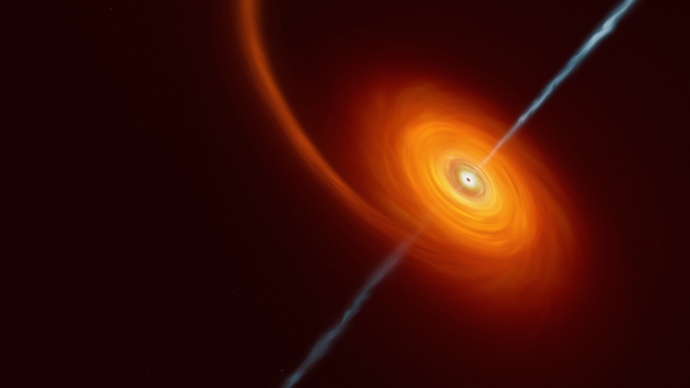NuSTAR Exposes a Black Hole Tearing Apart a Star
NuSTAR has brought out important information about one of the most energetic phenomena that occur in the universe. If a star comes too close to a supermassive black hole, the latter tears the star apart and that is what happened. This process is due to the fact that, one side of the star is closer to the black hole than the other side as gravity is stronger on for example the Earth in comparison to in orbit. But here the difference in the force of gravitation is much greater, which not only stretches a star but also rips it apart.
The flow of material which is produced is then spiralling around the black hole and some of it forms a bright ring called an accretion disk. In some cases,another source of light is relativistic jet also takes place which make place rarely. As the black hole continues to feed on the disk material which may take months or even years the event starts to fade.
Such events or processes are termed tidal disruption events abbreviated as TDEs and were predicted in the early 1970s and observed in the early 1990s. Currently, about 100 TDEs are known and only 4 of them are of jetted-TDE type.

On the 11th of February 2022, a new transient source was detected, during observations with the Zwicky Transient Facility at Palomar Observatory and marked as AT2022cmc. Because of its rapid increase and subsequent decrease in brightness that is more dramatic than a supernova, observations involving other telescopes across the world were conducted.
The data placed it into a jetted-TDE class, a very rare and highly luminous X-ray process. This created the first window for NuSTAR, the first focusing high energy X-ray telescope in orbit, to investigate an event of this nature. Due to the high sensitivity, NuSTAR was able to look into the X-ray energies and within a month of the observation of the ultra-stripped SN AT2022cmc, the team was able to get observational access thrice.
As far as lower-energy emissions from jetted-TDEs are concerned, many theories have been developed while the source of bright X-ray emissions are not fully understood. The most favored explanation for X-rays is that they are generated from the scattering of lower energy photons by relativistic electrons in the surrounding plasma but the works done by NuSTAR on AT2022cmc showed a clear break in the X-ray spectrum that does not support this theory.
This break hints synchrotron radiation-the phenomenon at which charged particles moving with relativistic velocity through a strong magnetic field emit radiation- as the source of X-rays. Dr. Yuhan Yao, with the help of her colleagues from UC Berkeley, has used this data to reconstruct the properties of the jet, which, apparently, should be mainly related to electrons, moving in a strongly magnetized jet, rather than protons.
New in AT2022cmc brings a considerable step forward in studying relativistic jets in astrophysical processes. To this, Dr. Yao pointed out that NuSTAR’s data directly contradicts the validity of such models, and indicated that magnetic reconnection is rather important in ‘kicking’ the particles in these jets.
Besides offering new knowledge about TDEs, this discovery also opens the door towards the understanding of relativistic jets in other high energy astrophysical objects like Gamma-Ray Burst. In this work, with the help of Dr Yao’s analysis, it can be concluded that is provides new insights for understanding the formation and acceleration of relativistic jets in the universe.
Do not forget to share your opinion with us to provide you with the best posts !



0 Comments